Chornobyl Report
A biweekly update of Chornobyl support activities for December 4, 1998
PDF Version (706Kb)--view with the free Adobe reader.
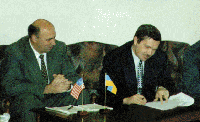 Slavutych Mayor Volodymyr Udovychenko (left) looks on as Oleksandr Skripov, deputy director of Chornobyl nuclear power plant, signs off on the contract for construction work on the heat plant administration building. |
Heat plant contract brings jobs to Slavutych
A team of Ukrainian contractors recently received a $1 million contract for construction work on the administration building for the partially complete Chornobyl site replacement heat plant. The team is led by the Kyiv-based Region Installation Branch of Yuzhteploenergomontazh (UTEM) and includes a contractor consortium from Slavutych called Promkomplekt (PK). The contract was awarded jointly by Chornobyl nuclear power plant (NPP), the Project Construction Management Group, and Battelle's Pacific Northwest National Laboratory (PNNL) in Richland, Washington. The U.S. Department of Energy (DOE) and the U.S. Agency for International Development are providing the funding, of which more than $600,000 will be allocated to the PK consortium.
Construction of the new heat plant supports the scheduled shutdown of Chornobyl Unit 3 and the long-term mission of decommissioning Units 1, 2 and 3. Chornobyl officials began building the new heat plant in 1992 but halted construction at about 25-percent completion. In late 1997, the United States agreed to work with Ukraine to finish the plant by mid-2000, thereby replacing an existing heat plant that is inadequate to support shutdown and deactivation work on the three units.
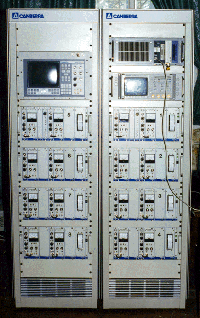 Racks containing electronic modules that process signals from neutron detectors in the nuclear fuel debris. |
New system to monitor nuclear reactivity
A team of PNNL specialists was in Ukraine this week to conduct post-installation testing of a prototype neutron monitoring system at the Chornobyl Shelter. The system was installed by Chornobyl NPP and Shelter technicians and soon will be used to monitor the reactivity of melted reactor fuel inside the Shelter.
Existing monitoring equipment has detected periodic increases in the neutron count rate, suggesting that uncontrolled fission reactions may be occurring. This could be caused by the accumulation of water inside the Shelter, which can increase the reactivity of the fuel mass. The new system is designed to provide detailed information on whether the high neutron count rate is indeed caused by fission reactions or indicates possible faults in the existing monitoring system. If fission reactions are present, U.S. scientists will work with Ukrainian nuclear experts to assess safety implications and the need for a permanent monitoring system that would be developed under the auspices of the international Shelter Implementation Plan.
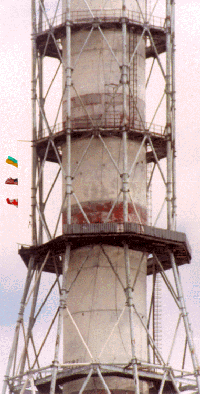 Flags of the United States, Ukraine, and Canada - the three countries that funded the vent stack repairs -- fly high in recognition of the international contributions to the project. |
Spreading the news on the success of vent stack repairs
Completion of extensive repairs to the ventilation stack between the operational Chornobyl Unit 3 and the destroyed Unit 4 this summer marked the first major physical safety improvement at Chornobyl NPP. The many challenges and successes experienced during the six-month repair effort were highlighted in a presentation given to international audiences on three occasions this fall.
PNNL's Brian Gore, deputy manager of the Chornobyl Shelter and shutdown/deactivation subprogram, gave the presentation, "Efforts to Assist in the Safety and Closure of Chornobyl" at the second annual conference of the International Chornobyl Center in Slavutych, Ukraine, in October, and to the Society of Sigma Xi in Vancouver, British Columbia, in November. Claus Herold, PNNL's onsite technical coordinator in Slavutych, also gave the presentation at the Chornobyl Shelter's 12th anniversary conference in Slavutych last month.
Unit 1 shutdown program approved
Notice was received this week that the Ukrainian government has granted final approval for the "Chornobyl NPP Unit 1 Shutdown Program" developed by Chornobyl plant and Slavutych Laboratory of International Research and Technology (SLIRT) personnel. The program calls for defueling of the Unit 1 reactor core by the end of 1999 and defueling of the Unit 1 storage pools by the end of 2003. Defueling of the Unit 1 reactor core is expected to begin by the end of 1998.
The shutdown stage for Unit 1also includes deactivation of systems and equipment no longer needed, removal of radioactive and hazardous materials from systems and facilities, decontamination of radiologically-contaminated systems, equipment, and facilities, renovation and continued operation of systems needed for the foreseeable future, and preparation of regulatory documentation needed for decommissioning of Unit 1. Final Government of Ukraine approval of the Unit 1 Shutdown Program represents a significant step forward in the deactivation and decommissioning of Unit 1.
Chornobyl NPP management also gave the final go ahead to conduct a comprehensive engineering and radiation survey for Unit 1. The survey, which is expected to be completed in about a year, will provide much of the information needed to determine the scope of work for permanent shutdown, deactivation, and interim safe storage of Unit 1.
More than 200 attend nuclear trade conference
The U.S. Department of Energy, in coordination with the U.S. Department of State and U.S. Agency for International Development, hosted a U.S.-Ukraine Conference on Nuclear Trade and Cooperation in Washington, D.C., on November 9 and 10. The conference brought together commercial interests from both countries to discuss and improve understanding about opportunities for nuclear commerce. It was part of DOE's efforts to help the Ukrainian private sector develop and commercialize nuclear technologies and products in cooperation with U.S. industry.
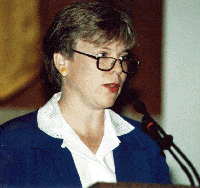 Rose Gottemoeller, director of DOE's Office of Nonproliferation and National Security, delivered the U.S. keynote address at the U.S.-Ukraine conference on Nuclear Trade and Cooperation. |
Rose Gottemoeller, director of DOE's Office of Nonproliferation and National Security, was the keynote speaker for the United States. Ukraine's First Deputy Minister of Energy, Mikhail Umanets, led the 50-person Ukrainian delegation and spoke on new directions in the Ukrainian nuclear sector.
Approximately 150 U.S. government officials and nuclear industry representatives heard about 20 technical and commercial presentations by officials from Ukrainian nuclear firms and institutes. The Ukrainian presentations focused mainly on Ukrainian commercial nuclear technologies and their potential for application in the United States. The conference also featured a special half-day session on the U.S. nuclear industry for Ukrainian participants that provided overviews by a broad range of individuals who represent different nuclear industry sectors. U.S. business representatives from a wide range of sectors in the nuclear industry.
Following the conference, DOE arranged for three-day visits to U.S. nuclear firms and sites around the United States for all Ukrainian participants. U.S. firms hosting these visits included Westinghouse Electric Company (both Pittsburgh and the Utah zirconium facility), Duke Engineering & Services (North Carolina), General Electric, Burns & Roe Enterprises, Scientech, the Electric Power Research Institute, Motorola, Morrison Knudson, Siemens, Bechtel, and WahChang of Portland. DOE national laboratories serving as hosts were Pacific Northwest National Laboratory, Oak Ridge National Laboratory, Brookhaven National Laboratory, and the Savannah River Radioecology Laboratory. (For more information, see the conference report page.)
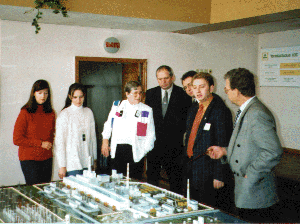 Richland City Council member Wanda Munn (center) asks a question during a briefing by a Chornobyl NPP representative. |
Partnership project moves forward
A delegation from the city of Richland, Washington, visited Slavutych, Ukraine, in November as part of the U.S.-Ukraine Foundation's Community Partnership Project. The project links U.S. and Ukrainian cities with the goal of providing local government training to Ukrainian government officials. Richland and Slavutych were selected this fall by the Foundation to participate in this international initiative.
LoAnn Ayers, who manages the Business LINKS Program for Washington State University-Tri-Cities, Wanda Munn, a member of the Richland City Council, and Tatyana Colgan, who works for PNNL on DOE's International Nuclear Safety Program, visited Slavutych to assess the town's local government training needs. Based on their assessment, a specific joint Richland-Slavutych local government training project will be selected.
Tony Lucenko and Volodymyr Parkhomenko of the Pylyp Orlyk Institute for Democracy, U.S.-Ukraine Foundation's Kyiv office, joined the delegation. The group met with Slavutych Mayor Volodymyr Udovychenko and other local officials to discuss city government structure, public works administration, the effect of upcoming free economic zone status on the Slavutych region and its economy, and the effect of the Chornobyl NPP closure on Slavutych.
The city of Richland's experience with economic diversification and decreasing the dependence on a federal nuclear site is similar to the situation being faced by Slavutych with the impending Chornobyl NPP closure. As a result, economic diversification, specifically as it relates to education and retraining of workers, was identified as the focus of the Community Partnership Project.
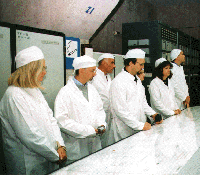 Members of the U.S. Congressional delegation are briefed about the use of emergency operating instructions in the Chornobyl Unit 3 control room. |
U.S. Congressional delegation visits Chornobyl and Slavutych
A delegation of U.S. Congressional staff members and U.S. Department of Defense officials visited the Chornobyl NPP site and the town of Slavutych on November 8 to learn more about U.S. efforts to improve safety at nuclear power plants in Ukraine. Leading the group were Madelyn Creedon and Monica Chavez, professional staff members with Senate Armed Services. They were accompanied by David Trachtenberg, House National Security; Colonel James Reid, Richard Rock and Stephen Guenther, with DOD's Office of Cooperative Threat Reduction; and Dan Jordan, U.S. Air Force staff military liaison officer.
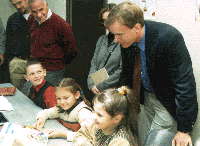 During a tour of the Slavutych Laboratory, the delegation got the chance to meet with some local youngsters attending private English language classes at the Laboratory. |
At Chornobyl NPP, the delegation was briefed by the site's director general, Vitaliy Tolstonogov, and toured the operational Unit 3 with deputy director Oleksandr Skripov. The delegation also received a tour of the Slavutych Laboratory for International Research and Technology and attended a special community reception in their honor.
News items and comments can be directed to INSP Communications, (509) 372-6015, or e-mail susan.senner@pnl.gov.
See also Chornobyl Initiatives/General Information on Chornobyl and the Biweekly Report Archive.